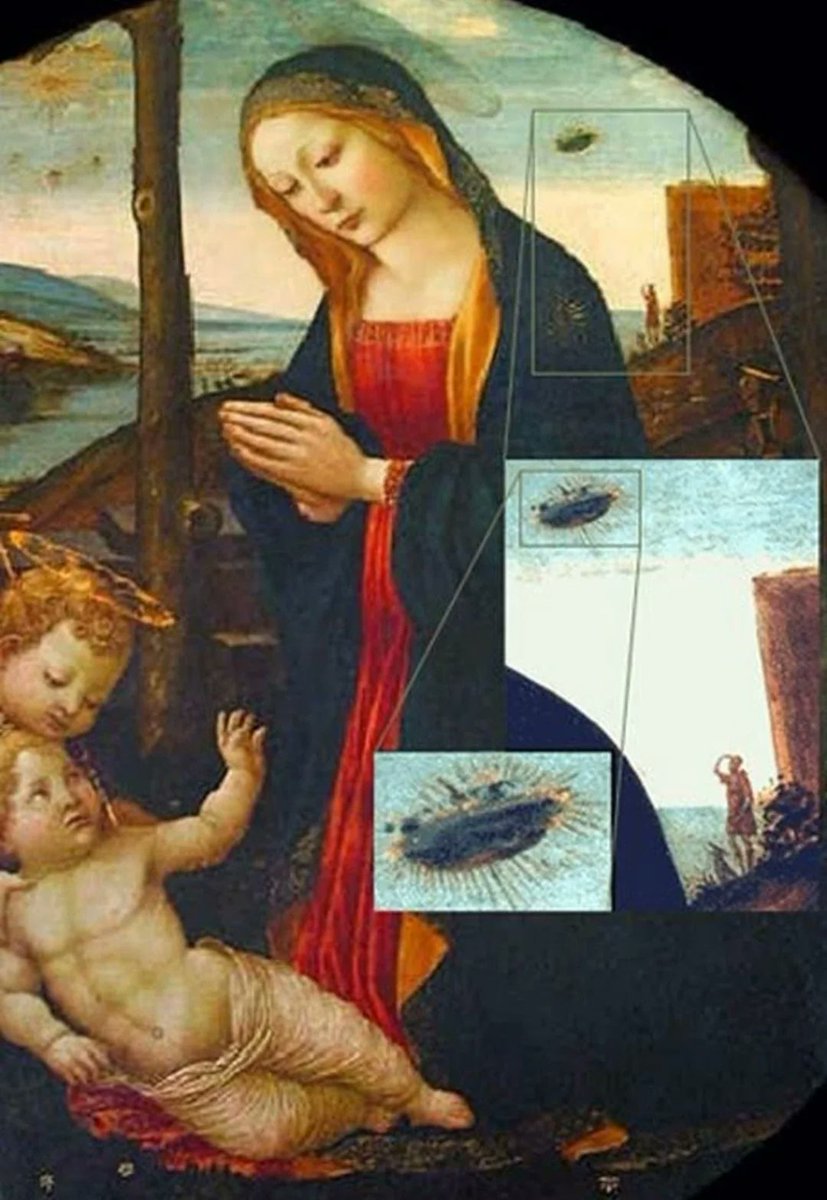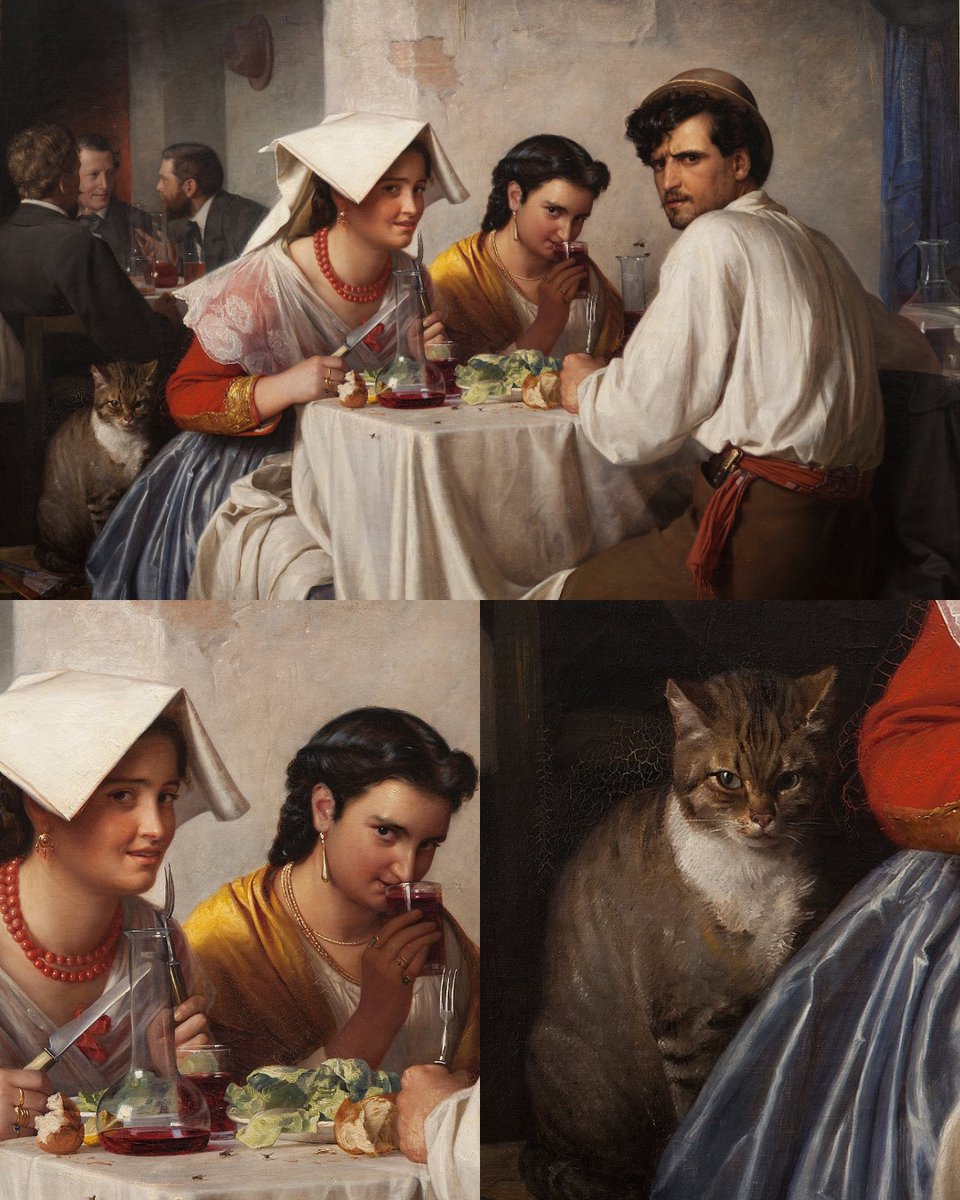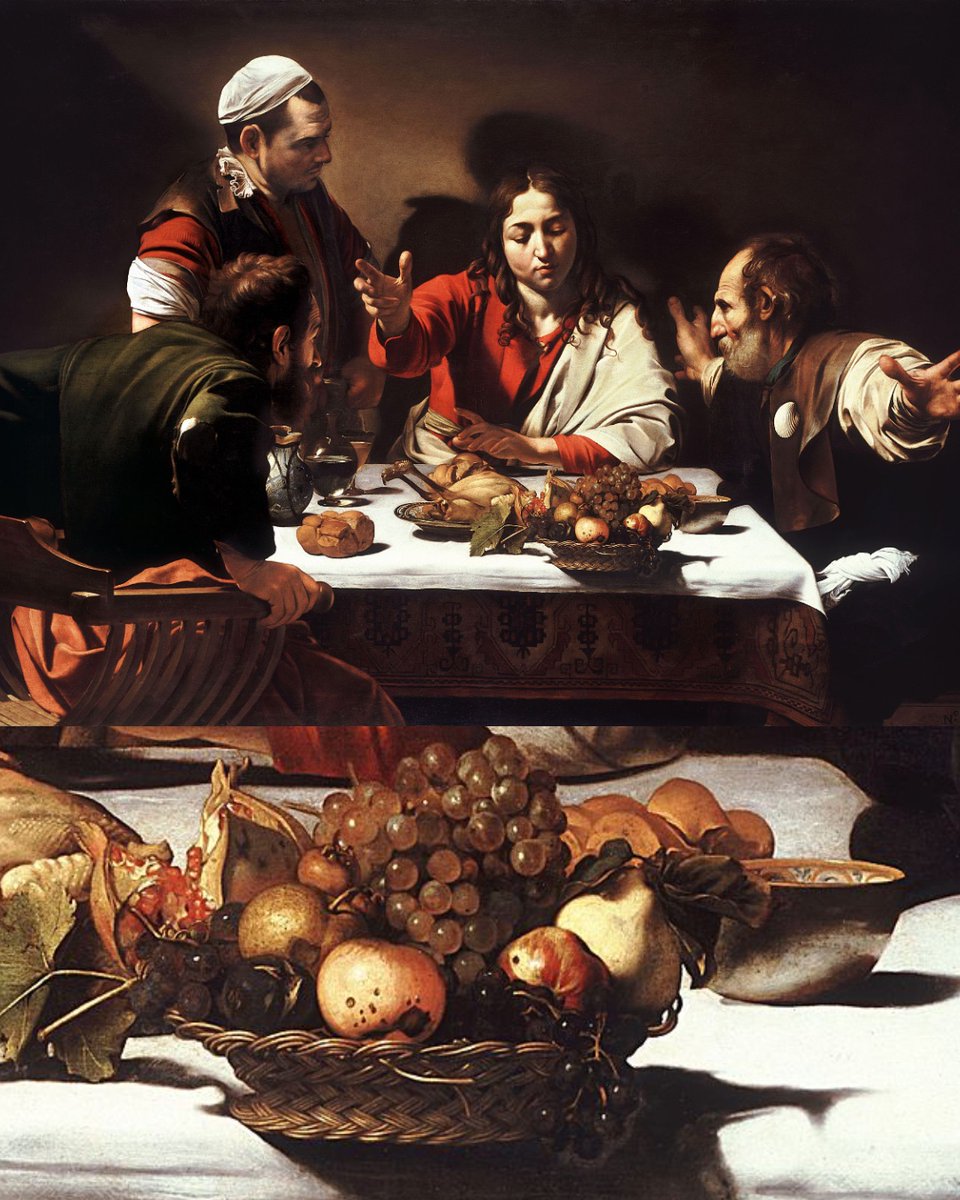Masterpieces with hidden details 🧵
1. Michelangelo's "Creation of Adam" may hide a secret: the section where God is placed resembles an anatomically accurate brain
1. Michelangelo's "Creation of Adam" may hide a secret: the section where God is placed resembles an anatomically accurate brain

2. John Dee, Queen Elizabeth I's occultist, was a close adviser and rumored spy who signed his work as 007.
In this painting, he performs a magical ceremony for the Queen.
An X-ray revealed a circle of skulls in the background—creepy or fitting for the "Queen's Conjuror"?
In this painting, he performs a magical ceremony for the Queen.
An X-ray revealed a circle of skulls in the background—creepy or fitting for the "Queen's Conjuror"?

3. This is "The Madonna with Saint Giovannino," a 15th-century painting attributed to Domenico Ghirlandaio.
A UFO can be spotted in the background, capturing the attention of a man and his dog.
Some interpret this as a "glory," a common angelic symbol in Renaissance art.
A UFO can be spotted in the background, capturing the attention of a man and his dog.
Some interpret this as a "glory," a common angelic symbol in Renaissance art.

4. Michelangelo’s "The Last Judgment" also hides anatomical secrets
Some scholars believe the flayed skin held by St. Bartholomew in the Sistine Chapel’s masterpiece is a self-portrait of Michelangelo, symbolizing his own spiritual torment.
Some scholars believe the flayed skin held by St. Bartholomew in the Sistine Chapel’s masterpiece is a self-portrait of Michelangelo, symbolizing his own spiritual torment.

5. This extraordinarily realistic painting by Carl Bloch, titled "In a Roman Osteria", is truly striking. However, there’s a detail you might have missed at first glance.
Everyone at this table is judging you.
Even the cat.
Everyone at this table is judging you.
Even the cat.

6. Raphael’s "The School of Athens" includes artists disguised as philosophers
Raphael painted himself among the great philosophers, and he also included his rival, Michelangelo, as Heraclitus—an ode to their intense rivalry and respect.
Raphael painted himself among the great philosophers, and he also included his rival, Michelangelo, as Heraclitus—an ode to their intense rivalry and respect.

7. While just 5.5 centimeters wide, the mirror in Van Eyck's "Arnolfini Portrait" reflects the entirety of the room, showing the couple from behind along with two other figures, one possibly being the artist himself. 

8. The concealed music in Bosch’s "Garden of Earthly Delights"
In the Hell panel, music notes are inscribed on a figure’s backside. Musicians have transcribed this "Hellish" melody into playable music.
In the Hell panel, music notes are inscribed on a figure’s backside. Musicians have transcribed this "Hellish" melody into playable music.
9. The secret skull in Holbein’s "The Ambassadors"
A distorted skull, only visible when viewed from an angle, stretches across the foreground—a memento mori symbolizing mortality.
A distorted skull, only visible when viewed from an angle, stretches across the foreground—a memento mori symbolizing mortality.

10. Dead grasshopper discovered in Vincent van Gogh painting
While the dutch artist painted in an olive grove, a grasshopper landed on his wet canvas. He carried on, creating the stunning artwork "Olive Trees" (1889), now part of the Nelson-Atkins Museum collection.
While the dutch artist painted in an olive grove, a grasshopper landed on his wet canvas. He carried on, creating the stunning artwork "Olive Trees" (1889), now part of the Nelson-Atkins Museum collection.

11. The dog hidden in Titian’s "Venus of Urbino"
The dog at the woman’s feet symbolizes marital fidelity, while the maid observing the girl rummaging in a chest represents motherhood. This painting's sensuality aligns with its domestic purpose as a gift from husband to wife.
The dog at the woman’s feet symbolizes marital fidelity, while the maid observing the girl rummaging in a chest represents motherhood. This painting's sensuality aligns with its domestic purpose as a gift from husband to wife.

12. Rembrandt’s self-portrait in "The Night Watch"—just one eye and a beret?
The painting shows how ordinary people can do extraordinary things. Rembrandt's presence is evident: zoom in on the guard in the center, and you can see what looks like the artist's eye watching.
The painting shows how ordinary people can do extraordinary things. Rembrandt's presence is evident: zoom in on the guard in the center, and you can see what looks like the artist's eye watching.

13. In his later years, Wolfgang Amadeus Mozart became a Freemason.
Is it mere coincidence that a portrait of young Mozart by an anonymous painter features a Freemasonry symbol?
The hidden hand pose, linked to many historical figures, may hint at his Masonic ties.
Is it mere coincidence that a portrait of young Mozart by an anonymous painter features a Freemasonry symbol?
The hidden hand pose, linked to many historical figures, may hint at his Masonic ties.

14. The painting under the painting
In Pablo Picasso's "The Old Guitarist," one can see a shape behind the man's head. Researchers used X-rays and infrared imaging, revealing 3 different figures beneath the surface. Picasso likely reused canvases due to financial constraints.
In Pablo Picasso's "The Old Guitarist," one can see a shape behind the man's head. Researchers used X-rays and infrared imaging, revealing 3 different figures beneath the surface. Picasso likely reused canvases due to financial constraints.

15. Caravaggio’s "Supper at Emmaus" includes a hidden fish.
A twig in the fruit bowl has frayed ends that curve to form a stylized fish, a Christian symbol dating back to the second century.
Not convinced? Zoom in to see a fish-shaped shadow to the right of the bowl.
A twig in the fruit bowl has frayed ends that curve to form a stylized fish, a Christian symbol dating back to the second century.
Not convinced? Zoom in to see a fish-shaped shadow to the right of the bowl.

16. Edvard Munch wrote a secret message on The Scream: “Can only have been painted by a madman.”
The National Museum of Norway confirmed that this barely visible pencil inscription is undeniably Munch's handwriting, added after his first, heavily criticized exhibit.
The National Museum of Norway confirmed that this barely visible pencil inscription is undeniably Munch's handwriting, added after his first, heavily criticized exhibit.

17. "Scheveningen Sands," painted in the 1600s, originally depicted people around a beached whale, which was later painted over.
A recent restoration revealed the whale, likely painted over because images of dead animals were deemed offensive in the 18th and 19th centuries.
A recent restoration revealed the whale, likely painted over because images of dead animals were deemed offensive in the 18th and 19th centuries.

18. An image of the human brain can be recognized not only in Michelangelo's "Creation of Adam" but also in another fresco: the "Separation of Light from Darkness".
Experts from Johns Hopkins suggest that overlaying a brain image on God's neck reveals a compelling connection.
Experts from Johns Hopkins suggest that overlaying a brain image on God's neck reveals a compelling connection.

19. The hidden message in Jan van Eyck’s "The Arnolfini Portrait"
Van Eyck’s signature on the wall behind the couple reads, "Jan van Eyck was here 1434," suggesting he was a witness to the scene depicted.
Van Eyck’s signature on the wall behind the couple reads, "Jan van Eyck was here 1434," suggesting he was a witness to the scene depicted.

20. In Caravaggio’s "Bacchus", a hidden image lurks in the carafe.
Discovered in 2009 through reflectography, art historians found a man sitting upright inside the carafe.
Some experts speculate it could be a 25-year-old Caravaggio himself, with dark curly hair.
Discovered in 2009 through reflectography, art historians found a man sitting upright inside the carafe.
Some experts speculate it could be a 25-year-old Caravaggio himself, with dark curly hair.

21. In Diego Velázquez's "Las Meninas," a figure nestled in the background is brought to life with subtle brushstrokes, creating a luminous effect that beautifully enhances the painting's overall depth and intricate layers. 

22. Did Van Gogh create his own version of the Last Supper?
Many art researchers believe so.
"Café Terrace at Night" features 12 seated figures and several hidden crosses. The shadowy figure in the doorway might represent Judas, according to scholar Jared Baxter.
Many art researchers believe so.
"Café Terrace at Night" features 12 seated figures and several hidden crosses. The shadowy figure in the doorway might represent Judas, according to scholar Jared Baxter.

23. Critics have debated the perspective in Manet's "A Bar at the Folies-Bergère" for a long time, but a photo reconstruction from 2000 proved its accuracy.
The way the barmaid and the gentleman's reflection are depicted shows Manet's groundbreaking artistic approach.
The way the barmaid and the gentleman's reflection are depicted shows Manet's groundbreaking artistic approach.

24. The figures in "The Music Lesson" by Johannes Vermeer are hidden behind furniture, unaware of being observed.
A closer look at the mirror shows the musician's gaze drifting from the keys, raising questions about her relationship with the teacher—could it be romantic?
A closer look at the mirror shows the musician's gaze drifting from the keys, raising questions about her relationship with the teacher—could it be romantic?

25. Did Leonardo paint his signature in Mona Lisa's eye?
The letters "LV" are visible in the right eye, likely standing for "Leonardo da Vinci". The left eye features symbols as well, but they are not as easily recognizable.
The letters "LV" are visible in the right eye, likely standing for "Leonardo da Vinci". The left eye features symbols as well, but they are not as easily recognizable.

Thank you for reading! If you enjoyed this deep dive into some of art's most obscure and mysterious details, please retweet the first post of this thread and follow me for more content!
https://twitter.com/jameslucasit/status/1842980521976168846
26. The devil is literally in the details...
This hidden face was discovered by historian Chiara Furgoni in 2011, nearly 700 years after the fresco was completed by Giotto.
The face features a mouth, nose, eyes, and horns among the clouds.
This hidden face was discovered by historian Chiara Furgoni in 2011, nearly 700 years after the fresco was completed by Giotto.
The face features a mouth, nose, eyes, and horns among the clouds.

• • •
Missing some Tweet in this thread? You can try to
force a refresh

















